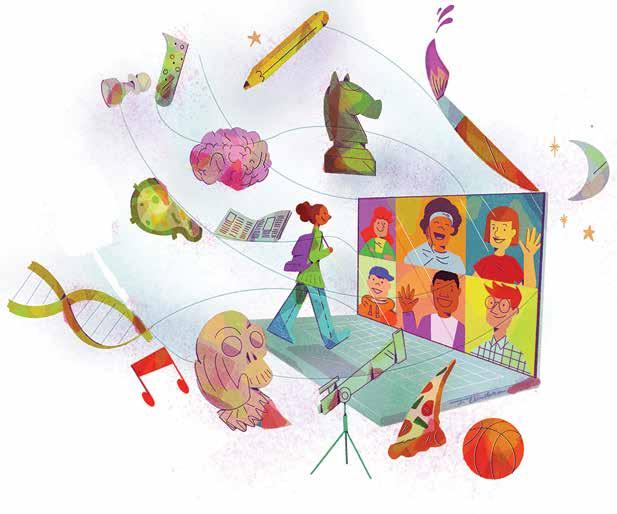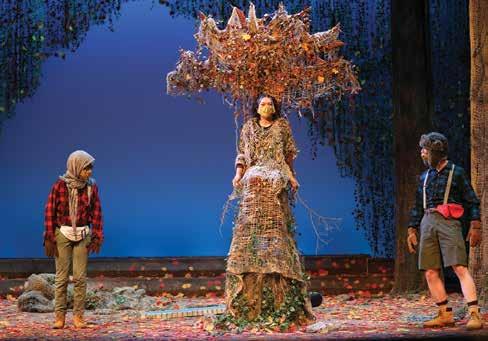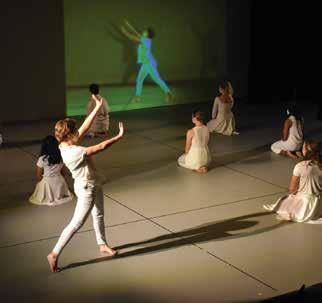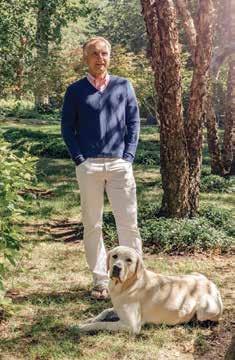
13 minute read
Table Talk: Assistant Principal Karen Lassey
so, mask-wearing students in the Phillips Hall classroom students. She is also club adviser to the Feminist Union, were separated from one another at the table by Plexiglas aka FEM Club, which hosts feminism-centered discusdividers. A 360-degree camera sat in the middle of the sions and events. “I hope to get back into the classroom table, which created greater cohesion and connection more, too,” she says. between those in-class and students joining remotely. Before the pandemic, Lassey was facilitating major Being back in the classroom, even in this novel form, was initiatives for the Academy — coordinating strategic a welcome development for Lassey. “It’s been so nice to planning eforts and overseeing and supporting the work interact with students in person again,” she says. of the directors of religious services, health services, and
The new format meant adjusting some of her teach- global programs. Working closely with Christina Palmer, ing methods. “I don’t typically do math instruction,” she director of student well-being and Holly Barcroft, general explains. “I try to empower students who have a unique counsel, Lassey manages the school’s response to sexual way of looking at a problem to speak up and help one misconduct allegations. Re-designing this process a few another.” To support her students years ago was “a collaboration during the fall term, Lassey occa- with a lot of people — deans, sionally created a video of herself faculty, student advisers demonstrating alternative strategies to solving specifc problems, once the “We had to and the students involved,” she says. “We worked with students had wrestled with them, to provide additional resources for them rethink almost students to get feedback and design protocols that are trau— something she would not have done previously. “Teaching remotely every aspect ma-informed. Nothing about these situations is positive, doesn’t replicate the classroom but it does draw on new opportunities,” she of the student but we try to put in as many supports as possible [for] all says. The in-person models that she and some of her colleagues used in experience students involved and that don’t diminish the agency of the fall will be deployed in 70 Exeter classrooms, across disciplines, when students return in the winter, with more in-person instruction planned for spring term. Lassey, who grew up in New Hampshire, didn’t envision joining the military. But when she received an Army ROTC fyer during her freshman year at Amherst College (and our support operations) through the lens of health and safety.” the reporting student. We’re trying to create a process that’s the least harming to students who come forward and encourages students to come forward.” Lassey is also deeply committed to Exeter’s anti-racism work. She completed her doctoral she was intrigued. “My grandfather, dissertation, which focused father and uncle were all in the on equity and inclusion, just army,” she says. “I’d never thought before the pandemic started. about it before then.” She received a ROTC scholarship “I was personally immersed in these topics for the last at Amherst, and after graduation, served as an army two to three years with an education leadership focus,” engineer during the frst Gulf War, supporting the design she says. She is putting her research into action, with a and construction of temporary roads and facilities in particular focus on data and equity. This winter, as part of Saudi Arabia. In 1993, she was deployed to Somalia. the school’s anti-racist curriculum, she is co-facilitating a “We built roads for dispersing humanitarian relief, and student group discussion entitled, “The Racialization of violence escalated while we were there,” she remembers. Scientifc Thought.” Lassey is also advising a student with “There were explosive devices in some of the areas where a senior project about equity with regard to education UN troops were operating, so we adapted our mission to policy in the U.S. building new and safer routes around those areas.” After Among Lassey’s takeaways from this challenging returning stateside, she taught at the U.S. Army Engineer year (and something she is familiar with) is the ability School in Missouri and worked in the private sector to respond to changing conditions — and learn from the before coming to Exeter as an instructor. She was named experience. “Sometimes, when you’re forced to adapt and dean of academic afairs in 2012 and became assistant adjust, you make leaps and bounds that are greater than principal in 2017. She remains actively involved in campus when you have the luxury of time,” she concludes. E life, living on campus, doing dorm duty and advising
Clubs in the Time of COVID
STUDENTS GET CREATIVE TO OFFER
THEIR PEERS POINTS OF CONNECTION
By Sarah Pruitt ’95
Ever since her prep year at Exeter, Maggie Wainwright ’21 has relied on Dramat, the school’s student-run theater group, to provide her with not only a creative outlet, but a strong sense of community. When the COVID-19 pandemic hit, and she and her fellow Dramat members dispersed to their respective homes for the all-virtual spring term, Wainwright saw that community come together again in a new way.
“As soon as we went online, club members jumped in with creative ideas and ways to connect,” Wainwright says. Dramat held two performances over Zoom during the spring, along with a virtual awards show on Instagram, complete with fake golden trophies mailed to the student actors, directors, designers and techies that had made those performances possible.
In the fall, most students returned to campus, but classes stayed virtual, and social distancing, mask-wearing, and restrictions on in-person gatherings remained in place. Faced with these challenges, Dramat and other clubs — along with afnity groups like the Afro-Latinx Exonian Society (ALES) and Asian Voices — again got creative in order to keep a vital sense of community alive for Exeter’s students.
The club heads have been aided in their eforts by the Student Activities Ofce, which worked hard to ensure that clubs could continue operations despite the ongoing pandemic-related restrictions. “This year we’re taking a more proactive approach to make sure that our clubs are accessible to all students, whether remote or in person,” says Joanne Lembo, director of student activities.
That nimbleness and creativity will carry into winter term, with the community once again scattered around the country and globe until mid-February. After setting a mandatory schedule for club and afnity group meetings in the fall, Lembo plans to ensure that scheduled club meeting times are in time zones that work for all club members, including international students. “We realized this fall it was not perfect for our remote students, especially when daylight saving time hit,” she says. “We’re looking to make it better in the winter.”
A VIRTUAL CONFERENCE
“In a typical year, we spend a lot of time preparing for conferences, which are held on college campuses,” says Nahla Owens ’21, co-president of Model United Nations, another popular club. “But because of COVID-19, it was difcult for us to even think about leaving campus or
bringing people to campus.” Asian Voices. With the arrival of the pandemic, his group
The club usually hosts its own Model UN conference shifted its structure from a straightforward biweekly at Exeter, inviting about 500 students from schools discussion to a rotating split between discussion and around the country. In March 2020, Owens and her other community-building virtual activities, such as four co-presidents started planning to have their annual watching movies together or playing online web games. conference go virtual. Held over a weekend in early For Halloween, ALES partnered with Asian Voices to November, Exeter’s one-day online Model UN confer- host a “Spooky Stories Night.” Courtney Marshall, an ence, PEAMUN XII, hosted delegates from all over North instructor in English, read short horror stories written America. Each delegate paid just $5 to participate, and by authors of color on Zoom, and her readings were all the admissions proceeds went to charities chosen by projected into a space at Grainger Auditorium. Students Owens and her co-president, Noah James ’21. attending in person enjoyed socially distanced snacks
“We wanted to use the oppor- of apple cider and cider doughnuts, tunity to be as non sibi a club as we while remote students were able to could possibly be, and raise money attend the reading virtually. for causes that we cared about while also bringing people into the fold that may not have had the opportunity to attend a Model UN conference “As soon as we went CLUB NIGHT REIMAGINED Signing up new members also took before,” Owens says. Along with the virtual confer- online, club on a new format this year. Normally, the fall Club Night has been so ence expanding its reach, it also allowed for a star speaker it might not members popular that it’s been held in one of the hockey rinks, Lembo says. This otherwise have drawn: Former U.S. Ambassador to the United Nations jumped year, instead of an in-person event, she created a page on ExeterConnect, Samantha Power delivered the keynote address, donating her time in with gave each club a dedicated school email address, and asked all club after a correspondence with James. creative heads to create up-to-one-minutelong videos to promote their clubs. AVOIDING “ZOOM FATIGUE” ideas and On the frst-ever Virtual Club Night in September, each club hosted As a leader of both Mock Trial and the Democratic Club, as well as Dramat, Wainwright has enjoyed the community provided through ways to connect.” its own Zoom meeting where interested students could get more information. The night was a success, with the sign-up page getting some 2,000 both virtual and in-person meetings. views, according to the Exonian. In the fall, she and her fellow club Owens, Wainwright and Lai agree heads petitioned Student Activities that clubs have been able to provide to allow them to hold in-person auditions and rehears- a sense of an all-important community, given that als, a process that Lembo says was open to any dorm, COVID-19 has limited the everyday social interactions class, club, or other group that wanted to meet in person. that students used to take for granted. “You can’t say ‘Oh, By November, Dramat had staged several student-run I’ll bump into you on my way to class, or on the way to productions, performing under a large tent set up near the dining hall,’” says Owens. “That kind of spontaneity The David E. and Stacey L. Goel Center for Theater and doesn’t really exist on campus anymore.” Dance. At such an anxious and unsettled time, club meetings
While meetings of both ALES and Asian Voices, an — whether virtual or in person — have given new students Asian student afnity group, have in the past centered on opportunities to meet people with common interests. discussion, simply moving that discussion online wasn’t Clubs are also the rare spaces where students from all enough, given that most students are spending much grade levels and dorms can interact. Last fall, Lai moved of their day in virtual classrooms already. “Convincing into the new all-upperclassmen dormitory in The Exeter people to spend another hour of their day being on Zoom Inn, and has relied on clubs for the chance to mix with is really hard,” says Owens, who is also president of ALES younger students. “It ties me back in with the Exeter and co-president of the Democratic Club. community so I’m not just this washed-out senior,” he
“Zoom fatigue” is real, agrees JaQ Lai ’21, who leads says. “It’s nice being able to connect in that way.” E
ON STAGE
THE SHOW MUST GO ON
Though the audiences were remote, the performances of our student musicians, dancers and players during fall term were as genuine as ever. To their dedication and the ability to overcome the limitations of the pandemic, we say “Bravo!” E A scene from“The Short Tree and the Bird That Could Not Sing.”


Instructor in Music Rohan Smith conducts in “The Bowld.”

Bai Xue ‘23 plays violin in the Chamber Orchestra concert. The Dance Company performs in the Goel Center.


The fall dance concert was titled “To Move Forward.”
Symphonic Prose
A CONVERSATION WITH NOVELIST DAN BROWN ’82
By Jennifer Wagner


Cults, conspiracy theories, dashing Ivy League professors — these are the elements we have come to expect from Dan Brown thrillers. But a timpani-playing kangaroo? That’s new territory for the bestselling author of The Da Vinci Code.
Brown’s latest page-turner, Wild Symphony, tracks the adventures of a diminutive mouse as he gathers a menagerie of animal friends to put on a concert. Each page of this genre-busting picture book for the under-10 set features a poem that imparts a life lesson and also an original musical composition.
The music, performed and recorded by Croatia’s Zagreb Festival Orchestra, is accessible through a smartphone app that allows readers to listen along. Of the book’s enhanced audio capabilities, Brown says: “I was eager to try to re-create the experience I had as a kid. Of reading a children’s book and listening to classical music — but also taking it a step further, such that the music you’re listening to is directly related to what you’re reading.” Brown has also hidden anagrams and word games in the illustrations for kids and adults to discover.
We spoke with the author about his new project over Zoom, where he was comfortably ensconced in the library of his New Hampshire home, just miles from Exeter’s campus.
CODY O’LOUGHLIN
So Wild Symphony has been in the works for years.
This has been 30 years in progress. It started with a little project called “SynthAnimals,” which I sold [in Exeter] at the Water Street Bookstore and Whirlygigs on consignment. It was a cassette tape and a little book that went with it. I forgot about it until I was on tour a couple years ago. I was giving an interview on Chinese National TV and the interviewer said, “Before you talk about your adult books, I want to talk about your children’s book.” I said, “I don’t have a children’s book.” He said, “Yes you do. We found it on eBay. Here it is.” They played a song. I read a poem. We had a laugh and went on with the interview.
Then Random House said, “This could be a real thing if you double the size, write 10 more poems, 10 more pieces of music, orchestrate it for symphony and illustrate it.” I decided to do it.

Where did the idea for this fantastical story spring from?
I used to walk out in the [Academy’s] Gillespie reserve. I was writing music and poetry at the time and I heard a bunch of frogs in the river croaking. There was a big fat bullfrog and some high peepers and some frogs in the middle and it sounded like a fugue to me. I went home and I wrote a piece of music that was called “Happy Frogs.” And then I wrote a poem to go with it such that you would know what you were hearing. I must have been maybe 19 at the time.
You mentioned walking in the Academy woods. What was it like to grow up on campus in the ’70s?
I grew up in the dorms, Dunbar, Bancroft Hall and





